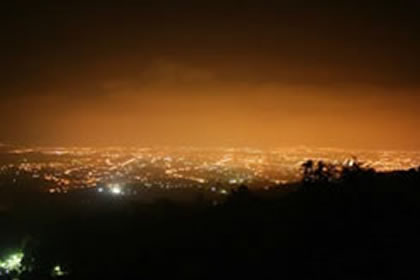A few years ago, talking about a possible threat in the skies was almost illogical. However, the concept of contamination or air pollution is something that is very common in large cities, and Chile is no exception. Its capital, Santiago, has high levels of smog, often reaching critical levels, especially in winter. However, if the skies in the Elqui area, considered the clearest on the planet, were suffering a possible contamination threat, it would be thought to be some kind of bad joke or something.
However, this problem does exist and is known as the phenomenon of "Light Pollution", produced by the diffusion of artificial light, causing a certain glow in the sky at night. But this is a phenomenon that occurs all over the world, not only in some places. We emphasize on the Elqui region, because there are large scientific and tourist observatories there. The invasion of this kind of pollution affects the vision of telescopes and the clarity needed to capture events that occur in the galaxy through the lens.
But, in Elqui there are no large cities. In fact, there are mostly small towns, except for Vicuña. Nonetheless, 55 kms. west, there are 2 major cities, La Serena and Coquimbo. Despite the distance from the astronomical centers, the artificial irradiation has affected the skies, resulting in the diminishing of the darkness of the night and the gradual disappearance of the light of the stars and other celestial bodies.
Light pollution is simply all the light that is not used to illuminate the ground and constructions and it is caused for 2 main reasons:
- Because the light beam does not aim downward.
- Because light radiation is a wavelength that the human eye does not perceive.
In the case of the observatories, the phenomenon will affect, in the way that the light that escapes into the sky is dispersed towards the telescope beam by dust molecules in the atmosphere. There are many ways in which light may be dispersed into the vision line, without necessarily having a city directly visible from the observatory. For example, the Cerro Tololo scientific observatory, which requires complete darkness ,is over 2 thousand meters above sea level. The cities of La Serena and Coquimbo can not be seen, they are hidden behind the hills bordering the coast. But, the light beams that are dispersed at this altitude are captured anyway.
How does light pollution originates?
The main way, undoubtedly, is through the use of public electricity supply networks of illumination that do not have properly designed screens to aim the light where needed and prevent the dispersion of light into the sky above the horizon. Some causes are:
- Indiscriminate use of globe-like illumination, with no screen.
- Lack of control over decorative lighting in buildings.
- Commercial ads with poor lighting.
Use of mercury vapor lamps (LVM), since the emission band of this type of light is very wide and some of its emission lines coincide practically with the nebula as well as emitting light outside the visible spectrum.
In astronomy today, generating increasingly modern giant telescopes, able to capture objects that are 250 million times more distant than the farthest star that can capture the human eye. To, successfully, carry out these observations it is imperative to provide a comprehensive critic to minimize the contributions of luminous nearby cities regarding the issue of the natural night sky.
Today, the Chilean state has put emphasis on this issue and seeks solutions. Supported by the regional governments of Antofagasta, Atacama and Coquimbo, they are impulsing the creation of emission standards in order to regulate Light Pollution, seeking to protect the quality of our skies, especially in the mentioned areas, and to avoid damage which in the future may cause deterioration in the quality of the skies in the north of Chile.






